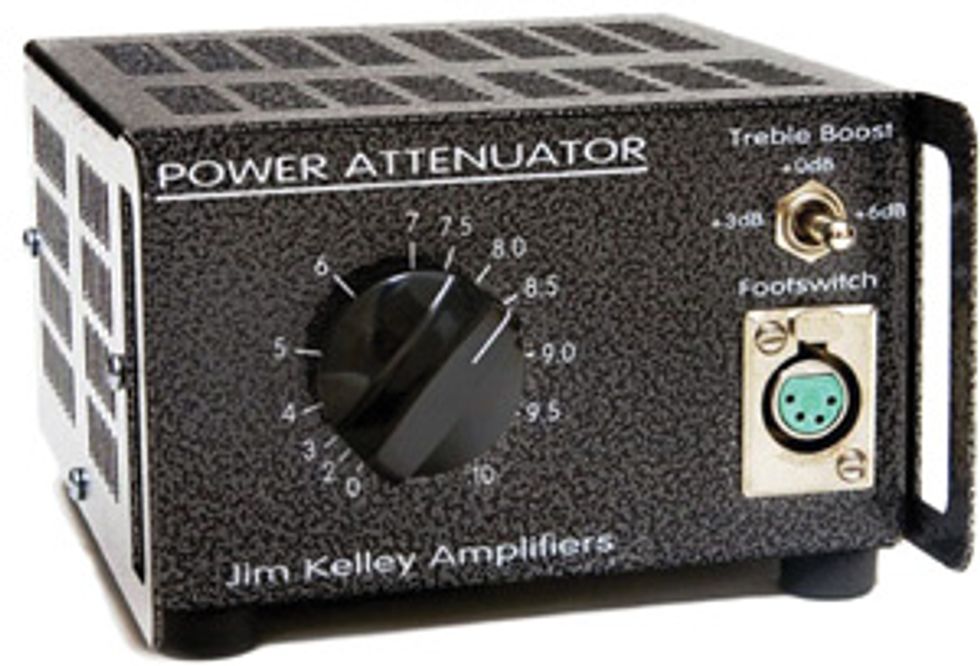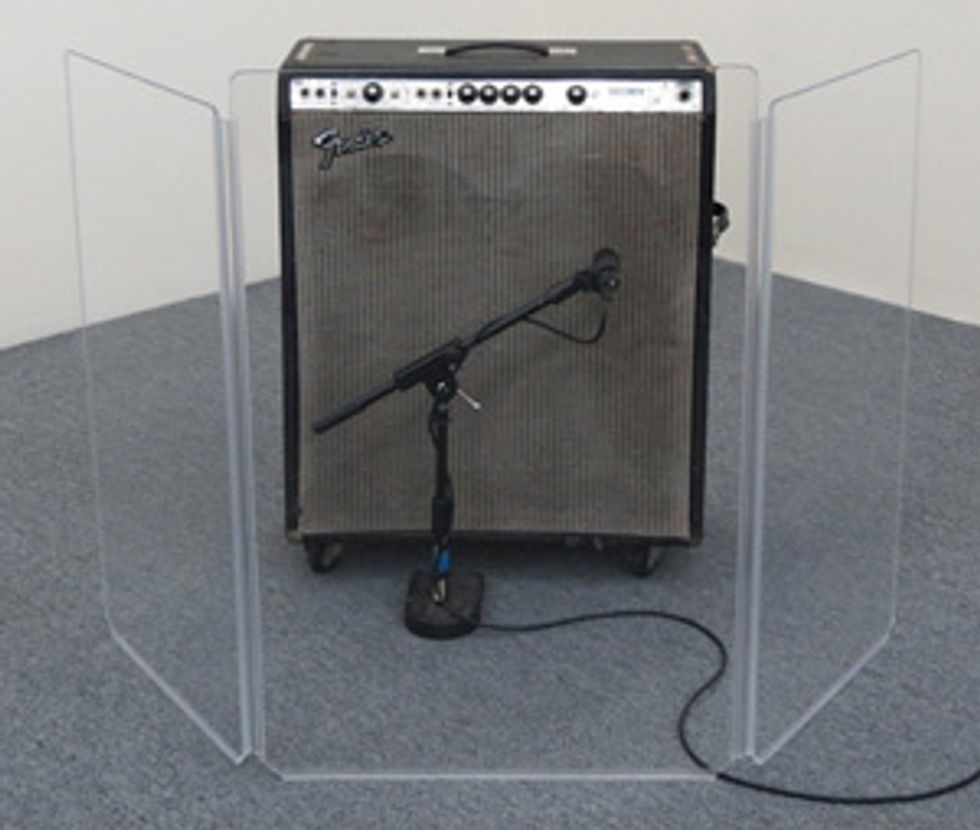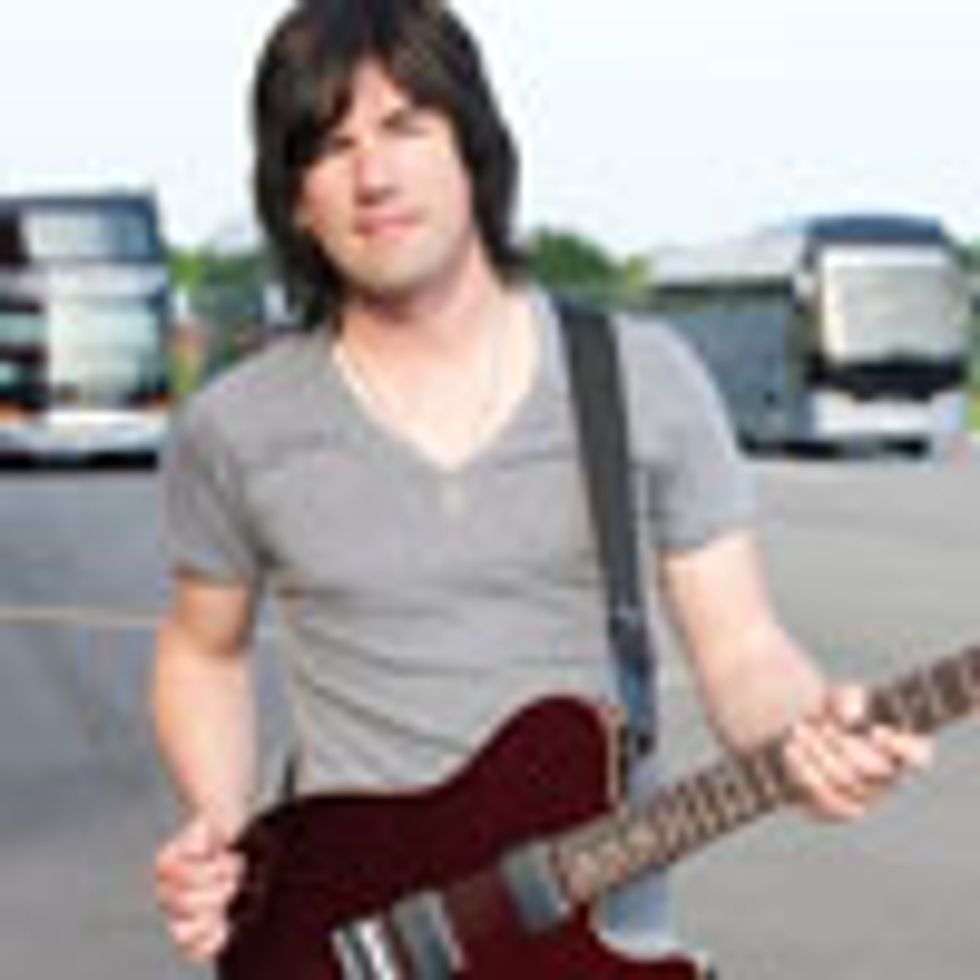
By incorporating a power attenuator like this model from Jim Kelley, guitarists can soak up excess cranked-amp volume without diminishing their desired tone.

Using an amp shield, like this AmpPac 32 from ClearSonic, is an easy fix for controlling loud stage volume and preserving the hearing of your front-row audience members.
“Turn it down!” Guitarists have been hearing this command since Leo Fender introduced the Broadcaster in 1948. But as guitarists, we know that tube amps just sound better when you turn them up and really move some air. Unfortunately, everyone from the local club owner to your lead singer to your mom just doesn’t seem to care—for them, it’s simply “too loud.” The good news is that today, there are plenty of great options out there for controlling stage volume. So for this month’s column, let’s talk about a few of them.
Low-power amps. It seems that the small, low-power, “lunch box” amps are all the rage lately. There’s a huge assortment of them out there, such as the Mesa Mini Rectifier, Traynor DarkHorse, Marshall’s 50th Anniversary 1-watt series, and the Orange Terror series heads and combos. These little amps pack a ton of great features and tones into a small package, and could be just the ticket for gigs where low volume is a priority. Of course, lower-power heads and combos have always been a great option for guitarists concerned about decibels and portability, especially when gigging in small venues. But having recently noticed a number of guitarists on big stages using low-power amps, I believe there’s a trend happening here. Guitarists have discovered that a low-power amp that’s cranked to its sweet spot can sound massive when mic’d through a big PA system. My pal Brian Ray, who plays with Paul McCartney, is just one example. He uses his signature Divided by 13 BTR 23 amp with a 2x12 cabinet for big arena stages. It’s a killer Marshall-inspired design, but at 23 watts, it keeps the volume to a dull roar.
It may be that a bigger, 50- to 100-watt head is what floats your boat. Following are a number of options for keeping the bigger volume under control.
Speakers. The more speakers you use, the more air you will move. So, simply using fewer speakers will help reduce your stage volume, but you have to be careful not to exceed your speaker-wattage rating. The sensitivity rating of each speaker is also an important consideration. For example, a Celestion Vintage 30—with a sensitivity rating of 100 dB—will seem significantly louder at the same amp settings than a Celestion Heritage G12M Greenback, which has a 96 dB sensitivity rating. We aren’t talking about a reduction from ear-splitting to bedroom volume here, but if knocking a few dBs off to get your stage volume under control is a concern, a speaker with a lower sensitivity rating can be helpful.
Master volumes. Most guitarists understand that a master volume reduces the signal coming from the preamp prior to going into the power section, thus reducing volume. Turning down the master will lower your volume, but you might sacrifice some tone in the process since a big part of our tone can come from driving the power section of an amp. But, not all master volumes are created equal. The post-phase-inverter master volume (aka PPIMV) has recently become popular with some amp builders, because it comes after the phase inverter in the amp circuit, which is technically part of the power amp. So, when you crank up the preamp gain, you’re also driving the phase inverter hard, which contributes greatly to that cranked-up, power-amp tone.
Attenuators. A power attenuator can be a huge asset when trying to reduce the volume of a cranked-up tube amp. By patching an attenuator in between the amplifier output and speaker cabinet, the attenuator absorbs some of the output and reduces the volume accordingly. There are a number of models available on the market and most have handy features like line outs to drive effects or a slave amp. Personally, I use the Jim Kelley and the Aracom PRX150-DAG power attenuators. The Kelley has a footswitch which allows you to bypass it, just in case you do want to blast at full volume for a solo boost, while the Aracom has the nice feature of adjustable impedance, so you can safely match an amplifier with a 4 Ω output to a 16 Ω cabinet.
Amp shields and baffles. Joe Bonamassa is a terrific guitarist who likes to play loud. To deflect the intense beam of sound that can come from a cranked 4x12 and avoid deafening the fans in the first 10 rows at his shows, Joe started using plastic amp shields in front of his speaker cabinets. In fact, he even has a signature model amp shield with the JB-4 from ClearSonic.
Slaving and speaker simulators. Rush’s Alex Lifeson uses powerful tube heads, but he runs them into Palmer PDI-03 speaker simulator/load boxes. These devices allow a guitarist to crank a tube amp into “the zone,” and then safely reduce the output from the amp to line level. The PDI-03 also processes the line out signal and adds speaker simulation (the characteristic sound of a closed-back cabinet with a 12" speaker). A setup like this allows you to achieve total silence onstage, giving the front-of-house sound guy total control over your tone in the PA. Better hire a good sound guy!
Power scaling. The basic concept of this exciting technology is that by lowering the voltage to the output stage of a tube amp, you can lower the volume and make the amp clip at a lower level—while still retaining that cranked-amp feel and tone. Fortunately, power-scaling kits can be installed by a qualified tech on amps that don’t have it onboard.
It’s really a great time to be a guitarist. With so many options and gear choices available now, it’s relatively easy to achieve the cranked-amp tones we crave, at volume levels appropriate for any situation. Until next month, crank it up and then turn it down!
 Pete Thorn is an L.A.-based guitarist, currently touring with Melissa Etheridge. His solo album, Guitar Nerd, is available through iTunes or cdbaby.com. Read more about his career at peterthorn.com.
Pete Thorn is an L.A.-based guitarist, currently touring with Melissa Etheridge. His solo album, Guitar Nerd, is available through iTunes or cdbaby.com. Read more about his career at peterthorn.com.













